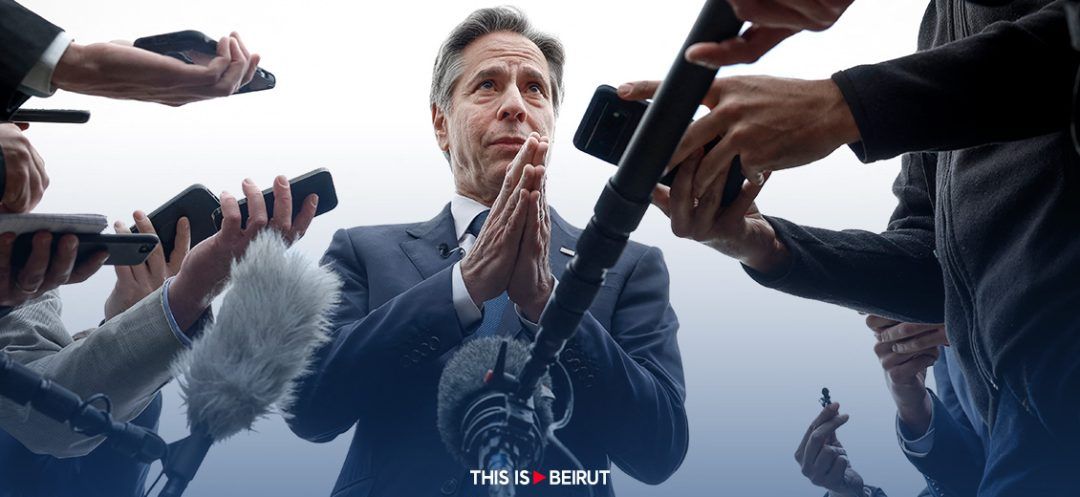- Home
- War in the Middle East
- Blinken Fails to Convince Israel of a Solution

A plethora of solutions were proposed following the outbreak of the war in Gaza, sparked by Hamas’ “Al-Aqsa Flood” operation. The aim is to halt the killing machine annihilating the lives of civilians, over 23,000 of them so far. The latest suggestion came from Qatar. It provides for the exchange of hostages and detainees between Israel and Hamas, a ceasefire spanning 3 months, the return of the displaced to north Gaza, the creation of a financing body to rebuild the city, and the withdrawal of the Israeli Army in parallel with the exit of Hamas leadership from Gaza.
The proposal was apparently to the liking of Washington, which dispatched Secretary of State Antony Blinken on his fourth visit to the region since the start of the war, to convince Tel Aviv – and the Palestinians – of this “partial solution”.
But Did Blinken succeed in his mission?
At present, the third stage in the Gaza war is about “limiting military operations and making attacks more accurate to avoid further civilian casualties.” Israel shared with Blinken its conditions for withdrawing from Gaza; Hamas and its fighters must leave and the administration of the city is to be handed over to an internationally sponsored Arab force, supervised by a new Palestinian authority established by Mahmoud Abbas as per the Egyptian initiative.
According to an Israeli official, the American Secretary of State failed to convince the Israelis of the urgent nature of a ceasefire and the importance of finding a solution, especially that the military operation did not deliver the results that Prime Minister Benjamin Netanyahu had expected. Evidently, Blinken heard no statement from Netanyahu’s government pertaining to the ceasefire and the two-state solution. Internal political struggle and the opposition’s calls for Netanyahu’s resignation, have only radicalized the prime minister further, but in the end, according to diplomatic sources, “no matter how stubborn he gets, he cannot stand against the country that provides him with arms and money.”
In parallel, US President Joe Biden’s special Coordinator for Global Infrastructure and Energy Security, Amos Hochstein, made a brief visit to Lebanon. His mission consisted of containing the confrontations between Hezbollah and Israel in South Lebanon, thus standing in the way of Netanyahu’s desire to escalate the conflict.
In Beirut, Hochstein shared “Israeli questions that need urgent answers regarding the front in the South and the implementation of resolution 1701” with caretaker Prime Minister Najib Mikati. An Israeli official stated that the American emissary’s visit to Lebanon was aimed at “receiving guarantees about the cessation of attacks.” The answer came in the form of a statement made by Mikati during a Cabinet meeting last Friday: “The current situation is better than it was two months ago. The international community is now more accepting of Lebanon’s position that was communicated to American envoy Amos Hochstein. We would like to remind everyone that some international resolutions were formulated as early as 1949, all the way to resolution 1701, and that all were violated by Israel. We, on the other hand, maintain that we abide by international law, and our ministerial statement is irrefutable proof. To maintain stability in the south, all resolutions must be implemented, including the 1949 armistice agreement in all its terms, without any amendment whatsoever.”
Hochstein communicated Mikati’s answer to Tel Aviv, and made proposals to Lebanese officials aimed at reaching a settlement. He asked “what would Lebanon do after the ceasefire?”, and insisted that Israel wants a diplomatic solution, not a military one, according to an Israeli official. The latter added, however, that “time is running out as far as the diplomatic solution is concerned.” In this context, some observers believe that Israel might wage a short war in the south of Lebanon, in order to prevent Hezbollah from making any surprise move and to isolate the southern front from the conflict in Gaza.
Hochstein’s proposals and ideas also highlighted Israel’s desire to reassure its settlers (near the border with Lebanon), prompting a reaction from a Lebanese official who stated that “any solution found in Lebanon is part of the solution in Gaza, and any solution in Gaza will include Lebanon.”
Hochstein’s talks covered the post-Gaza war stage after it became clear that Hezbollah would not negotiate before a ceasefire was declared there. The American emissary also asked the Lebanese officials about the fate of resolution 1701, since Parliament Speaker Nabih Berri had told him that “Israel must implement the resolution and stop its encroachments on Lebanon’s land, airspace and waters.”
In one of his recent statements, Hezbollah’s Secretary General, Hassan Nasrallah, declared that “through its actions, Israel is legitimizing the deterring operations that the Resistance has been preparing for years.” Nasrallah claimed that “this allows Lebanon to liberate the rest of its territory, from the B1 zone to the Shebaa farms, down to the smallest acre of land, when the attacks against Gaza end.” He, however, stresses that “no words, no dialogue and no negotiations will deliver results unless the aggression on Gaza is stopped.”
According to certain observers, Nasrallah’s words are meant to be a message to the Lebanese opposition, implying that Israel’s full withdrawal from the occupied lands – from the 13 points of contention to Shebaa and Kfarshuba – would be the work of the Resistance alone.
Arab initiatives will keep coming, the US will still try to impose a solution, and Blinken’s constant touring of the region will continue. It remains, however, that no solution is foreseeable future.
Read more



Comments